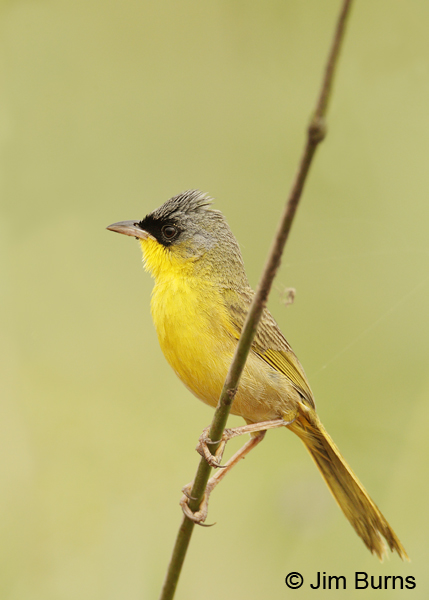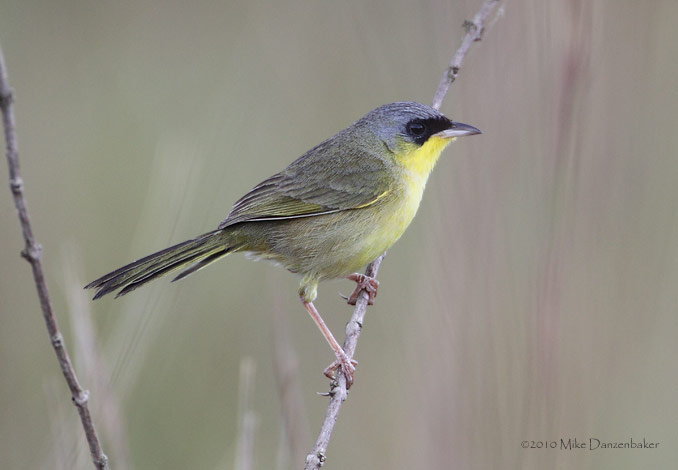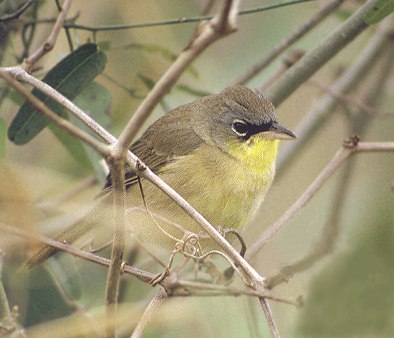Grey-crowned Yellowthroat
Meadows Yellowthroat ( Geothlypis poliocephala )
The meadows Yellowthroat ( Geothlypis poliocephala ) is a small passerine bird in the genus of the Common Yellowthroat ( Geothlypis ) in the family of warblers ( Parulidae ). Some authors make this kind in its own genus Chamaethlypis. Reasons are the other Gelbkehlchenarten missing compared pronounced, black face mask, the stronger beak, the longer, staggered tail feathers and the somewhat different song. The IUCN lists them as " not at risk " (least concern).
Features
The meadows Yellowthroat reaches a body length of 14 centimeters and weighs 13.2 to 16.2 grams. The wing length is 5.1 to 6.2 inches in the male, the female, 5.1 to 5.8 centimeters. The adult male of the nominate form has black bridle, a black eye area and a narrow black stripe on the front crown. To the eye there is a white eye-ring. The crown feathers and ear covers are medium gray, the neck and side of the neck plumage olive-gray and the top feathers olive. The wings are dark brown with olive-colored feather edges. The throat and chest plumage is bright yellow, the sides of breast and flanks olive-yellow and the tummy whitish- yellow.
The adult female of the nominate form is similar to the male. The crown and neck feathers and ear covers are olive-gray, the eye area and reins are dark gray and the eye-ring whitish- yellow to white.
Resources, nutrition and reproduction
The distribution area is located in Central America. The meadows Yellowthroat inhabits moist fields, hedgerows, bushy savannahs and similar vegetation. In south central Mexico it is also found in sugar cane fields. Mostly it feeds on insects and other invertebrates that ferrets out there mainly in the lower areas of vegetation. Occasionally it also lurks as the flycatchers on over flying insects. His deep, cup-shaped nest, it lays well hidden in the thick vegetation or in a grassy hollow. The nest is built of grass and lined with fine plant fibers and animal hair. The nest consists of two to four eggs ( the southern subspecies usually lay two). About the Bebrütungs and nestling period, there are no studies.
Subspecies and distribution
There are seven recognized subspecies:
- Geothlypis p. poliocephala SF Baird, 1865 - Mexico ( Sinaloa to Oaxaca )
- Geothlypis p. caninucha Ridgway, 1872 - From Oaxaca (Mexico ) to Honduras
- Geothlypis p. palpebralis Ridgway, 1887 - By Vera Cruz (Mexico ) to Costa Rica
- Geothlypis p. icterotis Ridgway, 1889 - From Nicaragua to Costa Rica
- Geothlypis p. ridgwayi ( Griscom, 1930) - From Costa Rica to Panama
- Geothlypis p. Ralphi Ridgway, 1894 - Tamaulipas and San Luis Potosi in Mexico; formerly also up to the extreme limits of the Southeastern Texas
- Geothlypis p. pontilis ( Brodkorb, 1943)










